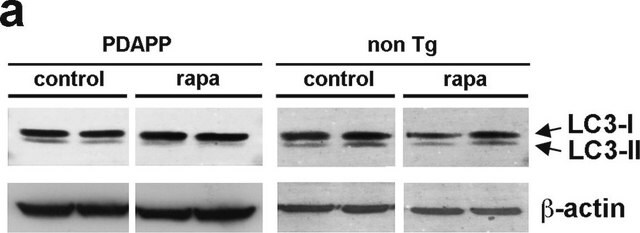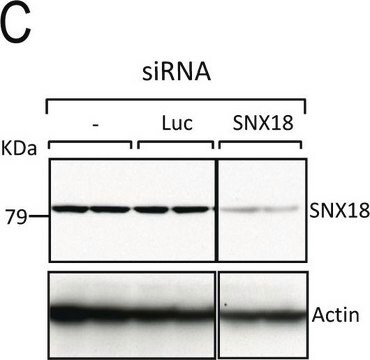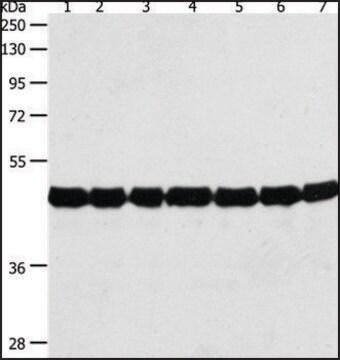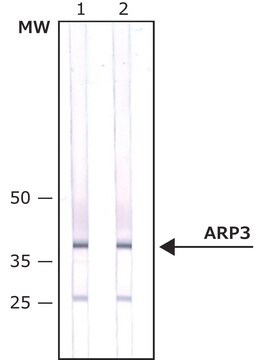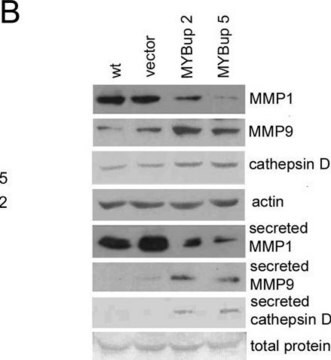A4700
Monoclonal Anti-Actin antibody produced in mouse
clone AC-40, ascites fluid
Sinônimo(s):
Monoclonal Anti-Actin
About This Item
Produtos recomendados
fonte biológica
mouse
Nível de qualidade
conjugado
unconjugated
forma do anticorpo
ascites fluid
tipo de produto de anticorpo
primary antibodies
clone
AC-40, monoclonal
peso molecular
antigen 42 kDa
contém
15 mM sodium azide
reatividade de espécies
human, Xenopus, hamster, mouse, guinea pig, rat, rabbit, snail, sheep, canine, carp, chicken, pig, bovine, viper, goat
técnica(s)
immunohistochemistry (frozen sections): suitable using methanol-fixed, frozen sections
indirect ELISA: suitable
indirect immunofluorescence: 1:200 using cultured human or chicken fibroblasts
western blot: 1:500 using cultured human or chicken fibroblast extract
Isotipo
IgG2a
Condições de expedição
dry ice
temperatura de armazenamento
−20°C
modificação pós-traducional do alvo
unmodified
Informações sobre genes
human ... ACTA1(58) , ACTA1(58) , ACTA1(58) , ACTA2(59) , ACTA2(59) , ACTA2(59) , ACTB(60) , ACTB(60) , ACTB(60) , ACTC1(70) , ACTC1(70) , ACTC1(70) , ACTG1(71) , ACTG1(71) , ACTG1(71) , ACTG2(72) , ACTG2(72) , ACTG2(72)
mouse ... Acta1(11459) , Acta1(11459) , Acta1(11459) , Acta2(11475) , Acta2(11475) , Acta2(11475) , Actb(11461) , Actb(11461) , Actb(11461) , Actc1(11464) , Actc1(11464) , Actc1(11464) , Actg1(11465) , Actg1(11465) , Actg1(11465) , Actg2(11468) , Actg2(11468) , Actg2(11468)
rat ... Acta1(29437) , Acta1(29437) , Acta1(29437) , Acta2(81633) , Acta2(81633) , Acta2(81633) , Actb(81822) , Actb(81822) , Actb(81822) , Actc1(29275) , Actc1(29275) , Actc1(29275) , Actg1(287876) , Actg1(287876) , Actg1(287876) , Actg2(25365) , Actg2(25365) , Actg2(25365)
Procurando produtos similares? Visita Guia de comparação de produtos
Descrição geral
The antibody recognizes an epitope located on the C-terminal end of actin conserved in all actin isoforms. It specifically labels actin in a wide variety of tissues and species. The epitope recognized by the antibody is resistant to formalin-fixation and paraffin-embedding. Zinc-formalin, B5, ethanol, methacarn, Brunnel′s or Bouin′s solutions may also be used as fixatives.
Monoclonal Anti-Actin (mouse IgG2a isotype) is derived from the AC-40 hybridoma produced by the fusion of mouse myeloma cells and splenocytes from an immunized mouse. A synthetic actin C-terminal peptide attached to Multiple Antigen Peptide (MAP) backbone was used as the immunogen. The isotype is determined using Mouse Monoclonal Antibody Isotyping Reagents, Catalog No. ISO2.
Especificidade
Imunogênio
Aplicação
- in the detection of actin in HeLa cells, breast cancer cell line and leukemia cell line using western blotting
- in human fibroblasts by immunofluorescence detection
Ações bioquímicas/fisiológicas
The actin in cells of various species and tissues are very similar in their immunological and physical properties characterized by electrophoresis and amino acid sequence analysis.(from bulletin) They mediate cytoskeletal remodeling during T cell activation. Mutation in the γ-actin and β-actin gene is associated with a developmental disorder called Baraitser-Winter syndrome. Mutation in the γ-actin leads to hearing loss.
forma física
Armazenamento e estabilidade
Outras notas
Exoneração de responsabilidade
Não está encontrando o produto certo?
Experimente o nosso Ferramenta de seleção de produtos.
recomendado
Código de classe de armazenamento
11 - Combustible Solids
Classe de risco de água (WGK)
WGK 1
Certificados de análise (COA)
Busque Certificados de análise (COA) digitando o Número do Lote do produto. Os números de lote e remessa podem ser encontrados no rótulo de um produto após a palavra “Lot” ou “Batch”.
Já possui este produto?
Encontre a documentação dos produtos que você adquiriu recentemente na biblioteca de documentos.
Os clientes também visualizaram
Nossa equipe de cientistas tem experiência em todas as áreas de pesquisa, incluindo Life Sciences, ciência de materiais, síntese química, cromatografia, química analítica e muitas outras.
Entre em contato com a assistência técnica


